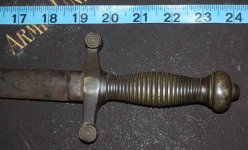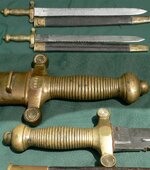johnnyi
Bronze Member
- Jul 4, 2009
- 1,887
- 144
- Detector(s) used
- minelab, white's xlt, deus xp, fisher aquanaut, white's twin box
- Primary Interest:
- Relic Hunting
"Dagger" I.D. needed please.
First of all, pay no atention to the blade size. After I cleaned the hilt I fitted a broken upper part of an Ames sword blade I had into the handle which I shaped so I could have a presentable letter opener on my desk. The tang length of the Ames happened to fit this handle exactly. The width of the blade I fitted is much narrower than the original blade would have been.
I found this mid-stream in Pa. in the Delaware river at low water. It's inside was encrusted with hard calcified sand.
It measures four and 3/4 inches long by 3 1/2 inches across at the hilt.
The impression left in the brass shows the ORIGINAL blade would have measured 1 1/4 inches across below the hilt.
Although the design matches some early swords, it seems too small for a sword, unless it's a "short sword". Can this be possitively identified? Thanks
First of all, pay no atention to the blade size. After I cleaned the hilt I fitted a broken upper part of an Ames sword blade I had into the handle which I shaped so I could have a presentable letter opener on my desk. The tang length of the Ames happened to fit this handle exactly. The width of the blade I fitted is much narrower than the original blade would have been.
I found this mid-stream in Pa. in the Delaware river at low water. It's inside was encrusted with hard calcified sand.
It measures four and 3/4 inches long by 3 1/2 inches across at the hilt.
The impression left in the brass shows the ORIGINAL blade would have measured 1 1/4 inches across below the hilt.
Although the design matches some early swords, it seems too small for a sword, unless it's a "short sword". Can this be possitively identified? Thanks




 Johnnyi
Johnnyi





